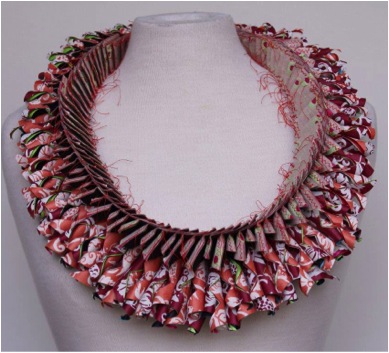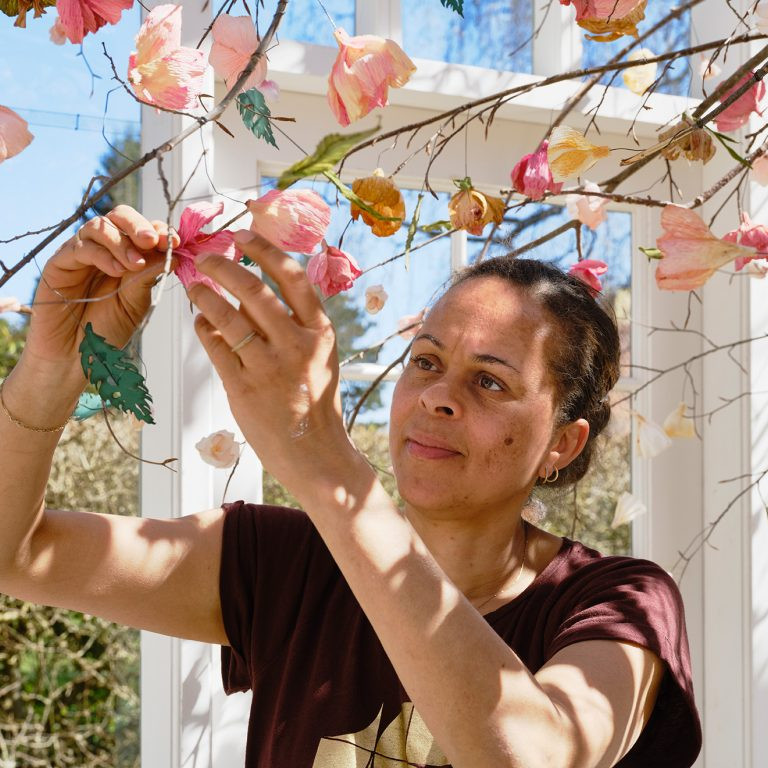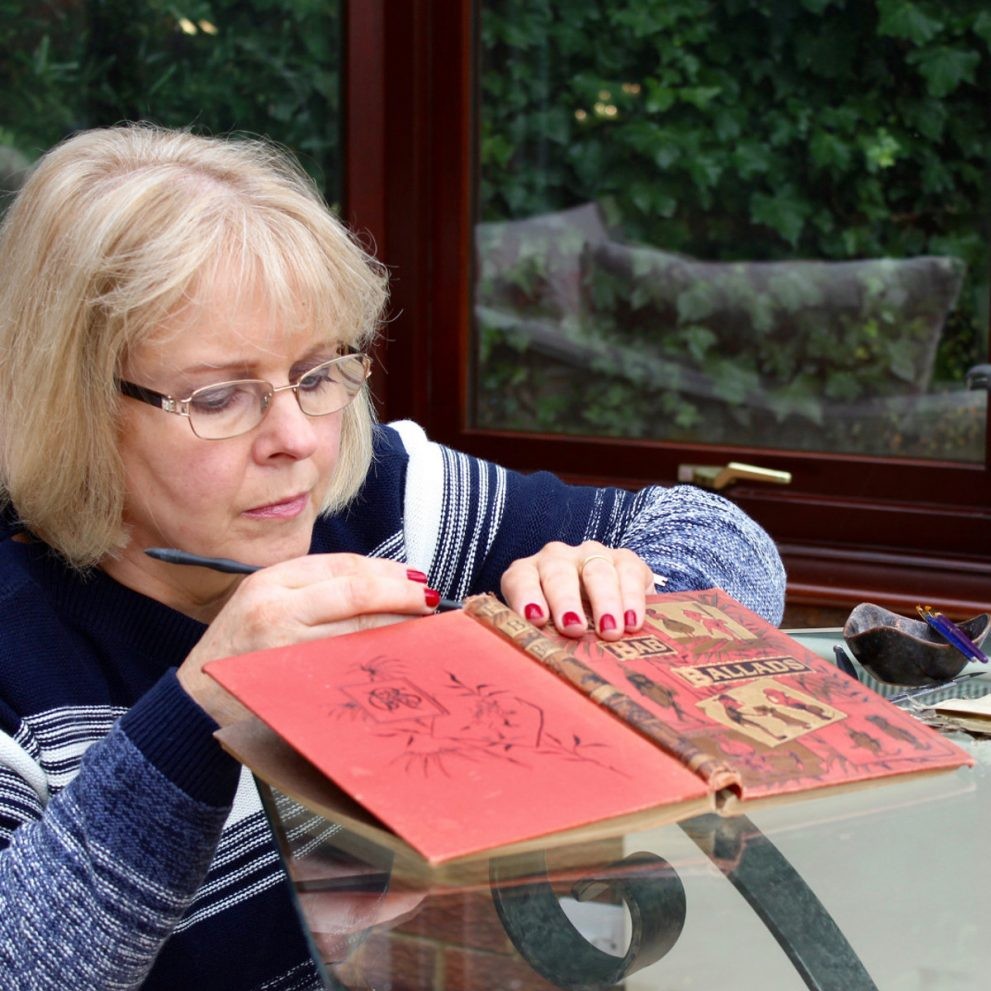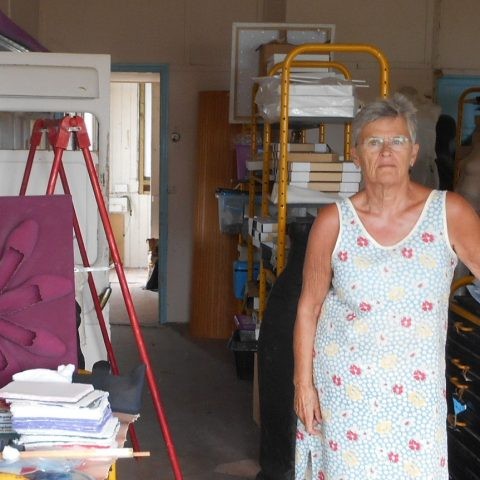Luis Acosta Paper Artist - Utrecht, The Netherlands
You have exhibited in both solo and group exhibitions in most European countries, Argentina, USA, Japan and South Korea. What are you exhibitions in 2013?
| 12 Mar – 2 Jun | Recent Jewellery Acquisitions, Museum of Arts and Design of New York |
|---|---|
| 12 – 28 Apr | NDF Bijoux Atelier, Verona – Italy |
| 3 – 19 May | INTENTION PAPIER 2013, Carré des Coignard, Nogent sur Marne, France |
| 22 – 28 May | Ian Gallery, Seoul, Korea. Korea Craft Designer Association, Annual Exhibition |
| 16 Jun – 8 Sep | Galerie help u zelven, Winterswijk, Netherlands |
| 6 Sep – Dec | Valtopina Museum, Valtopina (Perugia), Italy |
| Nov | Autoría BsAs, Buenos Aires, Argentina |
This list gives you a snap shot of how far and wide Luis Acosta’s work is going; and this is only 2013!
Do you find exhibition gives you motivation to look for new ideas?
To prepare for an exhibition is a ‘big job’ also a great incentive. You see everything that has been done and it may or may not generate new ideas.
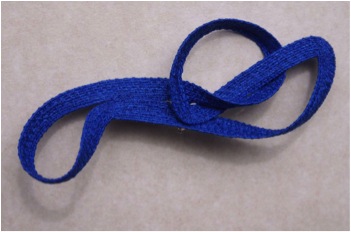
Quipus
How far ahead do you have to work to keep up with your exhibition timetable?
The programming is highly variable, running from 2-18 months. Whenever I have works available I like to present a few new pieces as the public may be totally different from a country to another.
How can people see your work apart from exhibitions?
Several galleries have works in stock like Spain, Switzerland and here in The Netherlands. Unfortunately, the economic crisis has affected me since 5 of the galleries I used to work with have to close their doors.
Although much of you work is jewellery it is often exhibited as instillations can you elaborate on this?
I always think of forms and ways to repeat them. From this starting point I can present my jewellery as an installation. Although the components of an installation may be the same, the setting is different in each space.
When I work I do not think of installations, I really think to exploit as much as possible the use of the same shape. For example the installation “Quipus” Consists of 5 different figures folded each in to 5 different ways. In results in total 25 pieces.
The fundamental basis of my work is my skills as a weaver. Already observe jewellery or textile installation, the pattern repeat element is always present. For example, in the use of colour in jewellery, I base myself in the iridescent twill.
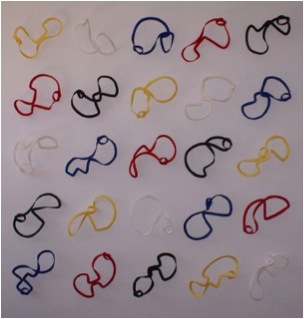
‘Installation- Quips’
You have your work in many museums and galleries. One piece is in the Museum of Arts and Design (New York, USA) can you tell us about this piece and the importance of this purchase?
It is important to be represented in this museum and at this international level. It was a surprise for me to get there. I worked with a gallery in New York; one of thier clients was interested in my jewelry and commissioned and donated the pieces that are now in the permanent collection of MAD.
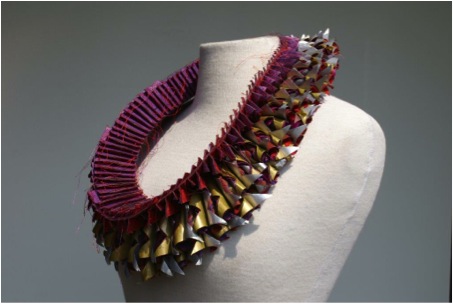
Necklace Collection MAD
How important is it to have your work in major collections?
It is the wish of any artist, to be represented in museums of international relevance.
It might or might not lead to new contacts.

Bracelet Collection MAD
You teach textile design and designing of women’s accessories can you elaborate on your teaching?
Students are not expected to create a finished object during the short duration of the workshop. The main purpose of the exercise is to enable students to develop or interpret their own ideas from a basic starting point.
Workshop “Perception of design (jewellery and accessories)”
This workshop attempts to approach the design from two points of view: design with a specific purpose and free form design.
1. Design with a specific purpose e.g.: bag, hat, jewellery, etc. Here there is a particular objective, but multiple ways in which it can be attained. All forms are acceptable.
2. Free form design. In this case the work consists of cutting and joining pieces of paper until a desirable form emerges.
Examples: The letter “L” (of Luis) inspired me to model one of my hats, which received “Special Mention” in 1988 in Stuttgart (Germany), during the International Competition of Textiles and Fashion Designers and is now part of the permanent collection of the Costum Museum of Buenos Aires (Argentina) and Textile Museum of Tilburg (Netherlands).
Workshop “Design of weavings” (own method)
1. The combination of colours to use in the warp (basically stripes) and the passage of a colour to another in an almost monochrome form (gradient) in warp and/or weft.
From the beginning, I assign each colour a number. I repeat this number combination until the design is finished and it is only at this moment that I place the colours to be used in the right position.
2. The technique to design a pattern of weave (following my own method).
For the making of these designs, at least four shafts are necessary. The result is a fabric of a lot of texture and movements.
The content of this workshop was published in the Spanish and Dutch magazines Oficio y arte (nrs: 11, 13, 15 and 17) and Textiel Plus (nrs: 141, 142, 145 and 146).
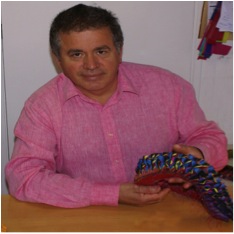
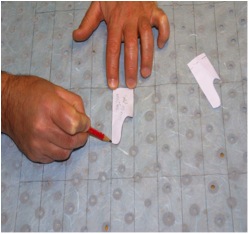
Apart from you jewellery you go large 2D and 3D textiles and instillations in paper, weaving and textiles tell us about these? Take one and expand on the technique and inspiration.
From my early work I was interested textile three-dimensional. First I wove tapestries with reliefs playing with different warps, later on a common loom I wove two-dimensional with three-dimensional effect. I worked thinking of this effect and all my work this concept is visible. The cube, in all its forms, is my inspirational figure.
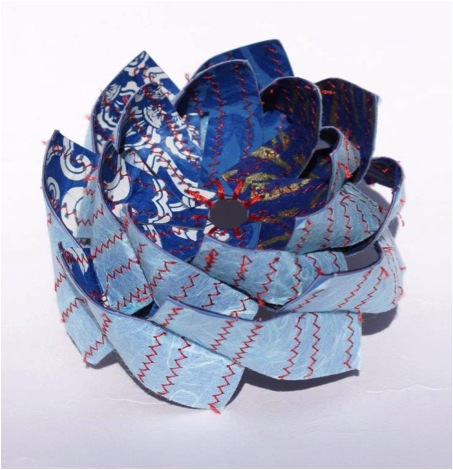
‘Brooch’
You have used history for the inspiration for the ‘Quipu’ series. Can you explain how this came about?
Through study, I tied a rope with knots that corresponded with the drawing of rapport. Over the years I realized that I had found nothing new; the Incas had used the same system before. So from then on all my work has focused on the Quipus.
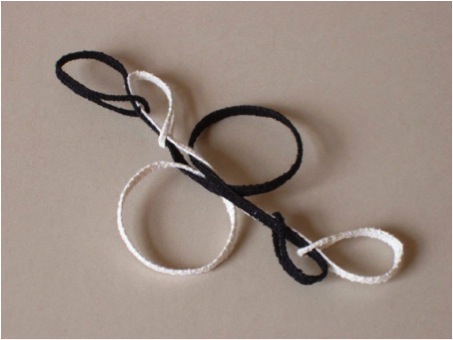
‘Brooch’
For example, in the series “Quipus” (knots in Quechua language) that the Inca’s used for their administration, each “knotted” object is made of paper threads presented in various ways.
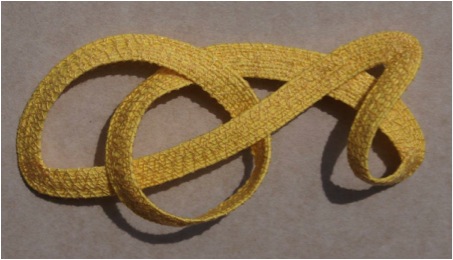
‘Brooch’
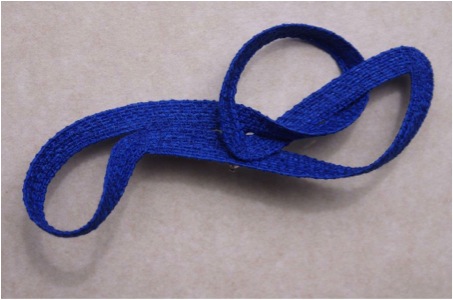
Quipus
Can you discuss the technique and design aspects of your necklaces?
To make a necklace of paper I should draw first each module that will integrate a necklace. Once the drawing is completed I add to that sheet of paper, six others. I sew (none of the papers are glued), then cut and stitch each module, one followed by the other, to form the necklace.
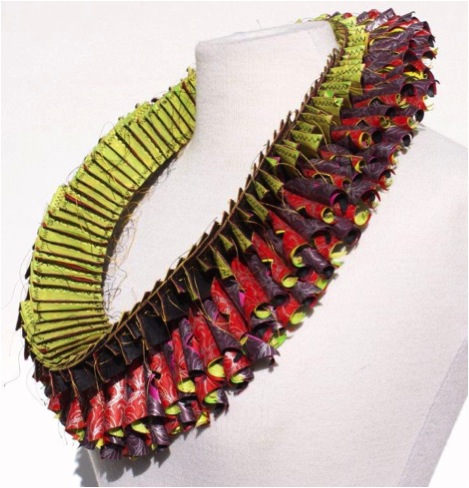
‘Necklace’
Instead, for a paper thread necklace, I draw a shape that will serve as a model for each link. Each of them is formed with the principle of the Möbius strip, which I will incorporate one Quipu (knot). Drawing, I copy while I sew the paper thread. I then proceed by engaging one by one to form the final necklace.
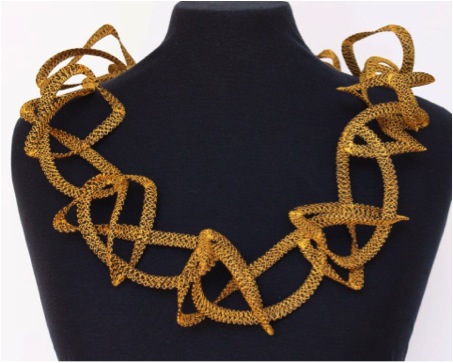
Quipus Necklace
When you use paper where do you source it from and what qualities are you looking for?
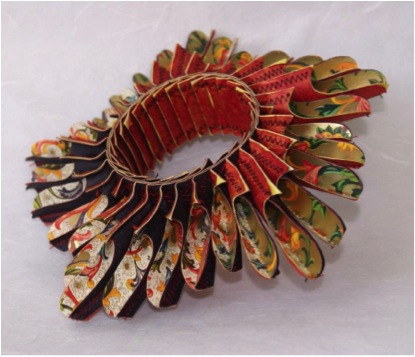
Bracelet
Every city I visit for the first time, the first thing I do is visit a paperwork store to see if there is paper that I can use. I buy just one or two sheets of each class.
I always use 6 layers of paper. The numbers 1, 3, 4 and 6 are usually handmade papers that come from Thailand, India, Japan, etc.. The numbers 2 and 5 are double-sided wrapping paper from Switzerland. These are the papers giving the desired rigidity to the pieces.
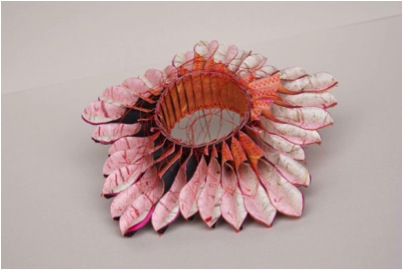
Bracelet
How durable / wearable is your jewellery?
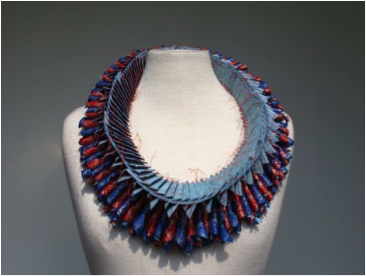
Necklace
The jewellery is made of paper, therefore, requires more care than other materials and with the passing of the years you may notice small changes as a result of use. It is quite sensitive to the influence of light.
You often mention the importance of form and how colour follows, can you elaborate on this?
For me, shape and color go together. For each piece I compose I first think about the module shape and then starts the long journey to choose the right combination of colors. Everything I do is designed to the smallest detail. If the public finds an error; my apologies.
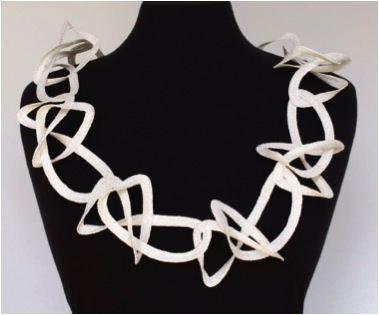
Necklace
Contact details.
Website: www.luisacosta.nl
+ 31 30 2938229
Email: ansacost@lombok.nl
Luis Acosta, Utrecht, The Netherlands
Interview by Deborah Blakeley, June, 2013
Think a colleague or friend could benefit from this interview?
Knowledge is one of the biggest assets in any business. So why not forward this on to your friends and colleagues so they too can start taking advantage of the insightful information the artist has given?
Other artists you may be interested in:


